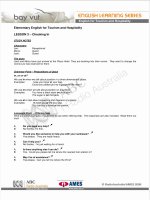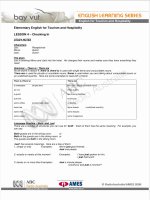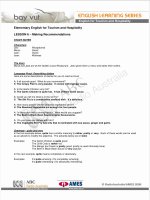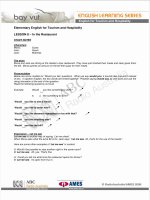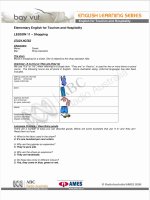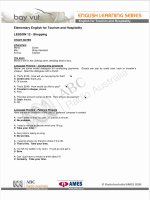REPORT: The field trip KOREA, tourism and hospitality service
Bạn đang xem bản rút gọn của tài liệu. Xem và tải ngay bản đầy đủ của tài liệu tại đây (4.55 MB, 61 trang )
A/ Korean travel industry
1. Resource values of Korea
1.1. Natural resource values
* Islands:
Nami Island (남남남): Nami is a semicircular river island located in Chuncheon, South
Korea. Since 2001, Nami Island has become one of the most popular tourist
attractions in Asia thanks to the success of the drama Winter Sonata. On the island
there is a lot of entertainment and there are exhibits of artwork made from recycled
materials.
Nami Island
Jeju Island ( 남 남 남 ): Jeju Island is the largest island off the coast of the Korean
Peninsula, and the main island of Jeju Province of South Korea. The island lies in the
Korea Strait, south of South Jeolla Province. The island contains the natural World
Heritage Site Jeju Volcanic Island and Lava Tubes.
Jeju Island
* Moutains:
1
Seoraksan Moutain ( 남 남 남 ): Seoraksan Mountain is the tallest mountain in the
Taebaek Mountains and is the symbol of Korea. The summit is called
Daechongbong, 1708 meters high, the third highest in Korea. This mountain is near
the city of Sokcho, Gangwon Province, northeastern Korea. The whole mountain is
considered as Seoraksan Nature Reserve, attracting many domestic and international
visitors.
Seoraksan Moutain
Hallasan Moutain ( 남 남 남 ): Hallasan is a shielded volcano on Jeju Island and is the
highest mountain in Korea. The area around the mountain is Hallasan National Park.
In the mountain there is Gwaneumsa, the oldest Buddhist temple on the island. The
old temple was built from the Goryeo. Like many other temples in the country,
Gwaneumsa was devastated and rebuilt in the 20th century. There is a memorial site
outside the temple to commemorate the victims of the Jeju Rebellion that took place
between 1948 and 1950.
Hallasan Moutain
* Beachs:
2
Haeundae Beach (남남남): Haeundae Beach is a beach in Haeundae-gu district, Busan,
Korea. With 12 km in length, the Haeundae beach is one of the most favorite and
famous beach in Korea.
Haeundae Beach
1.2. Cultural resource values
* Palaces:
Gyeongbokgung Palace (남남남): Gyeongbokgung is a royal palace located in northern
Seoul, South Korea. First built in 1395 and reconstructed in 1867, this is the main
and the largest palace of the five palace of Goryeo dynasty. Gyeongbokgung Palace
attracts tourists not necessarily because of architectural scale but perhaps mainly
because the garden is famous for its beautiful.
Gyeongbokgung Palace
Changdeokgung Palace (남남남): Changdeokgung is a palace located in a large park of
Seoul, Korea. Changdeokgung Palace was recognized as a World Cultural Heritage
in 1997.
3
Changdeokgung Palace
Deoksugung Palace ( 남 남 남 ): Deoksugung Palace is also known as Gyeongungung
Palace. The palace is located near the Seoul City Hall and is home to the National Art
Museum.
Deoksugung Palace
Changgyeonggung Palace ( 남 남 남 ): Changgyeonggung Palace is a palace located in
Seoul, Korea.
Changgyeonggung Palace
4
* Others:
Jongmyo Shrine (남남): Jongmyo is a shrine of the Kings and Queens of the Joseon
dynasty. According to UNESCO, this shrine is the oldest imperial shrine to be
preserved and rituals have continued in the tradition established since the 14th
century. Jongmyo was recognized by UNESCO as a World Heritage Site in 1995.
Jongmyo Shrine
Bulguksa Temple ( 남 남 남 ): Bulguksa is an ancient temple in North Gyeongsang
Province of Korea. In 1995, Bulguksa Temple and Seokguram Cave (4 km away)
was recognized by UNESCO as a World Heritage Site.
Bulguksa Temple
Hwaseong Citadel ( 남 남 ): Hwaseong is an ancient citadel located in Suwon, South
Korea, 30 km far from Seoul. It was recognized by UNESCO as a World Heritage
Site in 1997. The citadel is very beautiful with ancient stone wall.
5
Hwaseong Citadel
Gwanghwamun Plaza (남남남남남): Gwanghwamun Plaza is a public space on Sejongno
Road, Jongnogu District in Seoul, Korea. The square was opened on August 1, 2009
by the Seoul Metropolitan Government. It also has historical significance with the
statues of Yi Sun-sin of the Joseon Dynasty and King Sejong.
Gwanghwamun Plaza
Gyeongju National Museum (남남 남남 남남남): Gyeongju National Museum is a museum
in Gyeongju, North Gyeongsang Province, Korea. It holds a large number of
monuments of the Silla dynasty, with Gyeongju as the capital.
6
Gyeongju National Museum
Hanok Village in Bukchon (남 남 남 남 남 남): Hanok Village is a traditional Korean village
with a long history, located between Gyeongbokgung Palace and Changdeokgung
Palace. Today, it is used as a traditional cultural center, allowing visitors to
experience the same scene as that of the Joseon Dynasty.
Hanok Village in Bukchon
1.3. Entertaining resource values
* Amusement Parks:
Everland (남남남남 남남남): Everland is a park in Yongin, a city in Gyeonggi Province,
Korea. Everland is the largest theme park in Korea. In 2007, Everland was ranked
tenth in the world in amusement parks. Along with its main attractions, Everland also
includes a zoo and a Caribbean Bay water park. Everland is often compared to
Disneyland in terms of number of visitors to entertainment, architecture, scale, theme
and atmosphere.
Everland
Lotte World (남남 남남): Lotte World is a major entertainment complex in Seoul, Korea.
It includes the largest indoor amusement park in the world and has set a Guinness
7
World Record, open all year round, an outdoor recreation area called "Magic Island,"
an artificial island inside a lake Monorail, shopping complexes, luxury hotels, a
Korean folk museum, sports facilities, cinemas. Opened on July 12, 1989, Lotte
World serves more 7.6 million visitors a year with Tokyo Disney Resort is
considered one of the world-class amusement parks in Asia.
Lotte World
* Streets & Night Markets:
Myeongdong (남남): Myeongdong is one of the major shopping districts of Seoul with
shopping centers and retail stores of international brands. For young people, this is a
special area with a fashion center and nightlife. Myeongdong is the ninth most
expensive shopping street in the world. Myeongdong has four large department
stores: Migliore, Lotte Department Store, Avatar, and High Harriet.
Myeongdong
Dongdeamun (남남남): Dongdaemun is a large commercial district including traditional
markets and shopping centers in Jongnogu district, Seoul, Korea. As a popular tourist
and shopping destination, it has been designated as a 'Special Tourism Area' since
2002. The market sells all kinds of goods, but it is worth mentioning that silk and
8
fabric, clothing, shoes and leather goods, sportswear, plumbing and electronics,
support offices, fortune tellers, toys and food areas.
Dongdeamun
* Others: Namsan & N Seoul Tower
Namsan Mountain (남남): Namsan is a 262 meter high mountain in the Junggu district
of central Seoul, South Korea. This is a tourist destination with hiking, entertainment,
and visitor access to downtown Seoul's skyscrapers. N Seoul Tower is located at the
top of Namsan.
N Seoul Tower ( 남 남 남 남 남 ): N Seoul Tower is a communications tower and
observatory located in Namsan Mountain, central Seoul, Korea. It is marked as the
highest point in Seoul.
Namsan & N Seoul Tower
9
2. Korean State Apparatus
PRESIDENT
Moon Jae In
NATIONAL
ASSEMBLY
GOVERMENT
TRIBUNATE
NATIONAL ASSEMBLY:
NATIONAL ASSEMBLY
CHAIRMAN OF
NATIONAL ASSEMBLY
Chung Sye Kuyn
VICE CHAIRMAN OF
NATIONAL ASSEMBLY
VICE CHAIRMAN OF
NATIONAL ASSEMBLY
Shim Jae Chul
Park Ju Seon
BOARD & COMMITTEE
Board of the National
Assembly
STANDING COMMITTEES
Committee on Culture,
Parliamentary Library
Budget Budgeting Committee
Sports and Tourism
…
of the National Assembly
Legislative Census Committee
of the National Assembly
10
STRUCTURE: 300 seats
Goverment:
Democratic Party (121)
Independence (Chairman of the National Assembly) (1)
Opposition:
Free South Korean Party (107)
National Party (40)
Party Bareun (20)
The Righteous Party (6)
New People's Party (2)
Patriotic Party (1)
Independence (1)
Empty:
Drum (1)
11
GOVERMENT:
PRIME MINISTER
Lee Nak Yeon
Ministry of Planning and Investment
Kim Dong Yeon
(Deputy Prime Minister)
Ministry of Education
Kim Sang Gon
(Deputy Prime Minister)
Ministry of Science and Information Technology
Ministry of Foreign Affairs
Ministry of Unification
Ministry of Justice
Ministry of National Defense
Ministry of Public Administration and Security
Ministry of Culture, Sports and Tourism
Ministry of Agriculture, Forestry and Livestock
Ministry of Commerce, Industry and Energy
Ministry of Health and Welfare
Ministry of Environment
Ministry of Employment and Labor
Ministry of Gender Equality
Ministry of Land, Infrastructure and Transport
Ministry of Maritime Affairs and Fisheries
Ministry of Small & Medium Venture Business
Yoo Young Min
Kang Kyung Wha
Cho Myung Gyun
Park Sang Ji
Song Young Moo
Kim Boo Kyum
Do Jong Hwan
Kim Young Rok
Beak Woon Gyu
Park Neung Hoo
Kim Eun Kyung
Lee Ki Kwon
Jung Huyn Baek
Kim Hyun Mi
Kim Young Chun
Choi Su Gyu
(Temporary rights)
→ The Ministry of Culture, Sports and Tourism (Korea) (남남 남남 남남남 ) is a Ministry
within the Government of Korea, which is in charge of culture, sports, tourism, arts and
religion. The Ministry was established on February 29, 2008 on the basis of the functional
integration of the Ministry of Culture, Sports and Tourism, the Policy Propaganda
Department, the Ministry of Information and Communications (digital content service) .
The ministry has one minister, two deputy ministers and more than 60 subordinate
units. The department employs approximately 2,200 people. Some units under the Ministry
of Culture, Sports and Tourism are the National Museum, the National Theater and the
National Library.
The Ministry of Culture, Sports and Tourism has a minister, under which is two
deputy ministers. Directly under the ministry, there are also Policy Advisors, Spokesman
(Director of Propaganda Department) and Chief Inspector (Head of Inspection).
12
Under the 1st Deputy Minister:
• Office of Adjustment Plan
• Office of Religion
• Office of the Cultural Content Industry
• Bureau of Cultural Policy
• Department of Arts
• Tourism Bureau
• Library Policy Planning Group
Under the 2nd Deputy Minister:
• Public Information Division
• Department of Sports
• Department of Communication Policy
• Asian Cultural Center for Promoting Culture
3. Business Travel Network in Korea
3.1. The Seven Components of the Travel Industry
The travel industry comprises thousands of companies that produce products and
services for travelers. These companies range in size from small businesses to multinational
corporations. The roadside hamburger stand is just as much a part of the industry as is a
13
major airline. (And to a hungry traveler, the hamburger stand may be even more important.)
The combined efforts of all these travel and tourism companies enable people to travel from
one location to another. The companies can be organized into seven groups; or components.
according to their function.
Air transportation and services
Maritime transportation and services
Ground transportation and services
The hospitality industry
The tourism industry
Whosale and distribution companies
The travel mart
Three components provide the most basic service transportation. There are the components
that get people where they’re going:
14
Air transportation and services
Maritime transportation and services
Ground transportation and services
Two components care for and entertain travelers:
The hospitality industry
The tourism industry
Two components provide the means for distributing the products and services of the other
components to travelers:
Whosale and distribution companies
The travel mart
3.2. Business Travel Network in Korea
* Air transportation and services:
Speaking of Korea's biggest and most famous airline, many people will think of
Korean Air. However, in addition to the airline, there are still three Korean airlines are
equally famous in the country Kim Chi in particular and in Asia in general. Just know the
information about the flight of the four Korean airlines below you will be easier to travel in
the country of Kim Chi and neighboring countries.
Korean Air
Topping the list of the largest Korean airlines is Korean Air. It is also known as one
of the largest and most popular airlines in Asia. The company was established in 1962 by
the Korean government with the initial name of Korean Air Lines. However, in 1969, the
company was bought by Hanjin Shipping and named Korean Air. Since then, Korean Air
has become a privately owned and growing airline.
Currently, Korean Air has 158 aircraft. All of them are equipped with modern
facilities to serve the large air routes of 129 cities of more than 45 foreign countries. In
addition, with the experienced staff, enthusiasm and attractive services on the flight has
15
helped Korean Air bring many prestigious awards. Outstanding among them is the title of
one of the 30 best airlines in the world in 2014.
Asiana Airlines
Following the popularity and growth of Korean Air is Asiana Airlines. This is one of
the seven famous 5 star airlines in the world. With the motto of "maximum safety and
provide customer satisfaction services", Asiana Airlines has quickly captured the hearts of
travel enthusiasts in the world, especially in Asia.
Asiana Airlines was founded on February 17, 1988, but it took nearly 10 months for
the new carrier to make its first flight. Its head office is located at Incheon International
Airport and the inland hub at Gimpo International Airport. The airline's fleet is also quite
powerful with 85 advanced aircraft, specially designed seats, 2.6 m long, called Oz Quadra
Smartium in the merchant bay.
Not only that, but also on the passenger flights, the team's staff also teach origami,
magic show, violin and make fashion shows for passengers. Therefore, in 2012, Asiana
Airlines has been recognized by Skytrax as the best airline in Asia.
Air Busan
Although only established in 2007, Air Busan is one of the most famous Korean
airlines. The
official
name
is
Busan
International Airlines,
headquartered
in
Beomcheondong Road, Busanjingu District, Busan. With its modern design, luxury and
class services, Air Busan has captured a greater number of passengers from Seoul to Busan
than Korean Air.
16
Over the years, Air Busan has more than 10 aircraft, operating in domestic flights:
Busan - Gimpo, Busan - Jeju, Busan - Seoul ... and foreign flights with more than 10 other
destinations. each other around the world, mainly in Asia. And in Vietnam, passengers will
also easily buy Air Busan tickets to major Korean cities such as Busan, Jeju, Seoul, ... at
relatively low prices.
Jeju Air
At the end of the list of Korean airlines famous land of Kim Chi is Jeju Air. Founded
in 2005, Jeju Air is a Korean airline based in Jeju City, Jeju-do. It is owned by Aekyung
Group (81.7%) and Jeju Provincial Government (4.54%). On July 11, 2008, Jeju Air made
its first international flight from Jeju to Hiroshima.
Initially, the company focused exclusively on domestic routes between Jeju and the
Korean mainland via Jeju International Airport or Gimpo International Airport in Seoul,
South Korea. However, in recent years, Jeju Air has developed international routes in Asia
such as Bangkok, Philippines, Hong Kong, Japan and Vietnam. There are more than 10 Jeju
Air aircraft in between and some of them are ordered.
* Maritime transportation and services:
17
Seaports/ Cruise Ports in Korea
Cruise tourism, unlike a ferry whose purpose is to transport, includes the concepts of
a hotel, tourism, resort and transportation. A cruise ship refers to a ship that provides highquality services while cruising, regularly or irregularly, to beautiful tourist spots located
relatively far away. As the structures and functions of a cruise ship incorporate the
characteristics of hotels and resorts from the construction phase, cruise tourism possesses
distinct characteristics that are associated with a variety of industries. It is an industry, an
amalgamation of several industries, which creates added values through the goods and
services related to cruises.
The cruise market is considered to be a promising industry of the 21st century. It is
the fastest-growing high-value added tourism industry and is growing globally at an annual
average rate of 7%. (Cruise Industry News, 2016-2017). The total number of cruise
passengers has grown rapidly: 13.24 million passengers in 2005, 17.87 million passengers
in 2010, 20.42 million passengers in 2013 and 23.60 million passengers in 2016. It is
expected that the cruise tourism market in 2017 will reach 26.02 million passengers, a 10%
increase over 2016, and will continue to grow steadily annually: 27.40 million passengers in
2018 and 29.64 million passengers in 2019.
18
Up until now, the cruise tourism market has been formed around North America and
Europe. However, with the rapid development of China and the development of the tourism
industry in the Asia region, it is deemed that the cruise tourism market of the Asia region
will grow.
19
Recently in China, the desire to travel abroad among the Chinese population has
been increasing following its economic growth. The major foreign cruise operators,
realizing the trend in China, are actively offering cruise tourism products originating from
the ports of Tianjin and Shanghai: All three major international cruise operators, Royal
Caribbean, Princess Cruises and Costa Cruises, are based in Shanghai.
* Ground transportation and services:
Ground transportation in Korea is provided by extensive networks of Railways,
Highways, Bus routes and Ferry services. Korea is the third country in the world to operate
a commercial maglev train.
Railroad
The largest railway operator is Korail. Railway network is managed by Korea Rail
Network Authority.
Korea Train Express began service in April 2004, as Korea's first high - speed
service. Intercity services are provided by Saemaeul-ho and Mugunghwa-ho. Saemaeul-ho
generally stops less than Mugunghwa-ho and provides more comfortable seats and
20
service. Tonggeun (commuter train, not to be confused withsubways) serves some selected
lines. They stop in all stations and seat reservation is not available. On routes where KTX
operates, air travel significantly declined with less passengers choosing to fly and airlines
offering less flights.
New Nuriro-ho service was recently added between Seoul and Sinchang Station.
Nuriro-ho serves commuters around Seoul Metropolitan Area, providing shorter travel time
than Seoul Subway. The rapid trains have same cost and seat reservation as Mugunghwa-ho.
Korail plans to expand the service area. There's also a plan to introduce ITX-Saemaul,
which is supposed to replace Saemaul-ho. It began its operating in June 2014, and the train
will replace Saemaul one by one until 2025.
Subways
Seoul, Busan, Daegu, Gwangju, Daejeon and Incheon — all have subway systems.
Seoul's subway system is the oldest system in the country, with Cheongnyangnisection
of Line 1 opening in 1974.
Trams
The first tram line in Seoul started operation between Seodaemun and
Cheongnyangni in December 1898. The network was expanded to cover the entire
downtown area (Jung-gu and Jongno-gu districts) as well as surrounding neighborhoods,
including Cheongnyangni in the east, Mapo- Gu in the West, and Noriaangjin across the
Han River to the south.
The networks reached its peak in 1941, but was abandoned in favor of cars and the
development of a subway system in 1968. Seoul Subway Line 1 and Line 2 follow the old
streetcar routes along Jongnoand Euljiro, respectively.
Buses
21
Regional services: Virtually all towns in South Korea of all sizes are served by
regional bus service. Regional routes are classified as gosok bus ( 남 남 남 남 , "high
speed" express bus) or sioe bus (남남남남, "suburban" intercity bus) with gosok buses
operating over the longer distances and making the fewest (if any) stops en route.
Shioe buses typically operate over shorter distances, are somewhat slower, and make
more stops.
Local services: Within cities and towns, two types of city bus operate in
general:jwaseok ( 남 남 , "coach") and dosihyeong ( 남 남 남 , "city type") or ipseok ( 남 남 ,
"standing"). Both types of bus often serve the same routes, make the same (or fewer)
stops and operate on similar frequencies, but jwaseok buses are more expensive and
offer comfortable seating, while doshihyeong buses are cheaper and have fewer and
less comfortable seats. Many small cities and towns do not have jwaseok buses and
their buses are officially callednongeochon (남남남, "rural area" bus).
Other services: Incheon International Airport is served by an extensive network of
high-speed buses from all parts of the country. Beginning in the late 1990s, many
department stores operated their own small networks of free buses for shoppers, but
government regulation, confirmed by a court decision on June 28, 2001, have banned
department stores from operating buses. However, most churches, daycare centres and
private schools send buses around to pick up their congregants, patients or pupils.
* The hospitality industry:
Seoul
Last year, new hotel openings were mainly in the economy and midscale segments,
comprising international brands such as Ibis Styles, Holiday Inn Express, Four Points by Sheraton,
Best Western and local brands including Shilla Stay. The only luxury hotel opening in 2015 was the
317-room Four Seasons Hotel Seoul. The upcoming hotel pipeline consists of a few international
brands including the Hyatt Place Seoul and the Courtyard Seoul Namdaemun.
22
Busan
In 2015, approximately 647 rooms opened in Busan, the majority of which were classified
as economy and midscale hotels. Over the next two years, approximately 2.800 rooms are expected
to be completed in Busan with several notable international brands including Hilton and Kempinski
set to debut in the market. If all hotels materialise, Busan’s hotel supply will increase by a CAGR of
8,7%.
Jeju
Existing hotel supply in Jeju is dominated by Korean hotel brands such as Shilla and
Lotte as well as several owner-operated hotels. International brands are rare and limited to
the Ramada Plaza and the Hyatt Regency. However, with the development of the integrated
resorts such as Resorts World Jeju and Jeju Airest City, more international operators are
considering the longer term potential of Jeju as a regional resort tourism destination.
23
4. Travel companies and travel agenies in Korea
Korea Travel Company Co.,LTD
Representative: Woosik Chung
Business Inquiries: Soonchul Jang
Address: 65-5 S&S Bldg, Gyeoji-dong, Jongno-gu, Seoul, Korea
Phone: 82 2 737 5661
Fax: 82 2 735 8452
Homepage:
Email :
24
Korea Travel Company Ltd are veterans in the travel industry. We were the first
Korean DMC to host a series of school excursions from Japan all the way back in 1974 and
have been helping visitors from all across the world enjoy what our country has to offer ever
since. In addition to education tours, we also specialize in corporate incentive tours and
individual tours, F.I.T, and other kinds of package tours.
Korea Travel Company Ltd is adding to its comprehensive database all the time to
ensure all our clients have access to the best accommodation, transportation, restaurants,
resorts, and tourism facilities in the country.
Sarah Korea Co.,Ltd
Representative: Jinwook Sarah Lee
Business Inquiries: Jinwook Sarah Lee
Address: 303 A dong Brownstone Yeonhuiro 82, Seodaemungu, Seoul, Korea
Phone: 82 2 333 8364
Fax: 82 2 333 8365
Homepage:
E-mail :
Sarah Korea Co., Ltd is an event management company with 20 years of experiences
in the travel industry as a local supplier in South Korea. We deliver our service not to the
utmost range of client's satisfaction, but to those of touching with unforgettable memories.
Fulfilling Partners’ needs is our top priority knowing that little things make big
difference of result in business. Our most competitive professionalism which is based on
cost effectiveness and time efficiency with profound local networking would take into
satisfaction of global guests.
We are committed to provide a wide range of hospitality services including Meetings
& Conferences, Incentives, Business trip, Event management, Mega Sports Events, VVIP
services as well as Medical tourism.
Our highly trained staffs in every language will make guests’ business easier and
efficient.
Loyal guests could experience top privilege of our loyalty as rewards.
25
